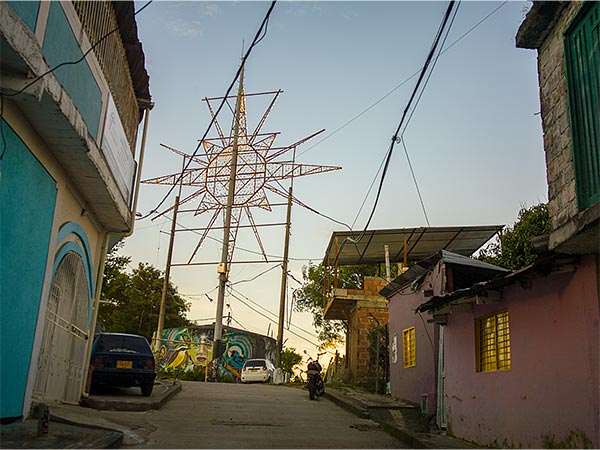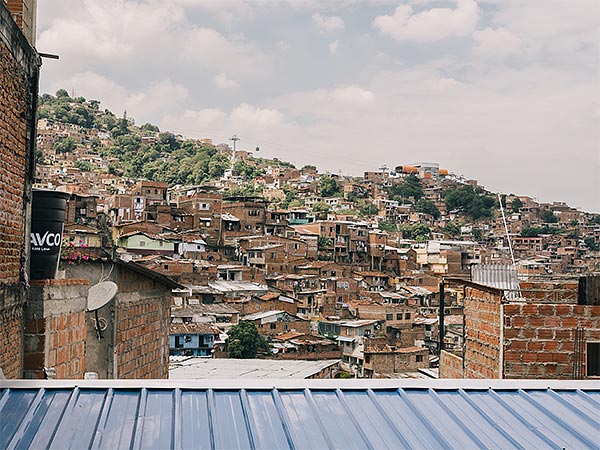Subtotal: $
Checkout
The Christmas Star of Siloé
A hilltop shantytown in Cali, Colombia, looked like a nativity scene even before the star appeared.
By Harold Muñoz
December 21, 2021
Available languages: Español
Some features only find their meaning when the world beyond recognizes them. And from that moment on, they also belong to the observer.
Observe the star of Siloé. According to David Gómez, who offers guided historical tours of the neighborhoods that make up the twentieth district of Cali, Colombia, this local feature is a far-flung imprint of Bethlehem’s. “Professor Alberto Marulanda was one of the first to notice that all this looked like a natural nativity scene,” David comments, gesturing as if sweeping the rooftops with his arm. And it was especially true at night back in the 1960s, when electricity hadn’t yet arrived to that hilltop squatter shantytown – one of many so-called “invasion neighborhoods” in Columbia – and Siloé was lighted with petroleum lamps. From the lower, established sectors of the city, it looked like a mountain of tiny lights which poured down the slopes like a lush curtain of luminous plankton.
A family-made nativity scene, like all works of art, takes on its own dimensions. The figures often vary in size, style, and material. So Marulanda’s metaphor makes sense in light of the ad hoc building materials used in Siloé, that crèche of spontaneous, communal creation that is under continual reconstruction. The first houses of cardboard, bamboo, and adobe were erected in the early twentieth century. Family homes were gradually improved with brick and mortar as economic circumstances permitted. More often than not, the structural rebar was – and still is – left sticking up from the flat rooftops like a promise that at some point, the next floor will be built. But sometimes houses cave in or are torn down by agents of the state, which still claims certain parts of Siloé. Yet the neighborhood invades again, imposing its time and form on the rest of the city.

The 2007 version of the star above the Emcali tank. All photos by Juan Arias. Used with permission.
Since this live nativity lacked a guiding light, explains David – who founded the People’s Museum of Siloé – Professor Marulanda convinced some local men to erect a star in Siloé. Leticia Loaiza, a local resident, concurs with David’s account: the joint fundraising effort took ten years, but they finally managed to construct a star over a pentagonal base. The idea to install it at the top of a tank owned by the city’s public utility company, Emcali, was initially thwarted by the company’s manager, Julio Mendoza. But after reconsidering – or perhaps seeing a political opportunity – Mendoza said that not only would he lend his tank, he would also have a metal support structure erected and foot the electric bill. And so the star became one of the main attractions in Cali’s Christmas array. Its inauguration in December 1973 was a big event. According to one of the city’s main newspapers, Diario de Occidente, the star was “a spectacle visible from any point in the city and beyond, because of its strategic location on a mountaintop.” Light travels in all directions and we see it because it has found us first. It is really the star which looks at us, and the masses attracted by it, from the mountaintop. And it calls us. And it overwhelms us, like every stark reality laid bare, because it forces us to see what is missing.
Some prefer to see stigma instead of light. John Guevara, a community organizer for Siloé’s La Estrella neighborhood, said that some people prefer to hide the fact that they live there, in the highest part of the district where the air is cleanest. If they admit it, they risk missing a badly-needed job opportunity or attracting the sideways glances of fellow caleños who live in other parts of the city. So some residents and a YouTuber named El Traveler are offering historical tours of the neighborhood. Unlike other circuits, these trips are made on foot: “The idea is that the people climb up the mountain and see how everything looks from up here, from my neighborhood,” says John. And although these trips don’t exactly fit the traditional definition of “tourism,” a walk through the district is often enough to dispel the shadows of its reputation.

View of Siloé.
The tour ends at a lookout which offers a view of the city encompassing all of Siloé. The neighborhood hangs unfurled beneath its star like a bridal veil. You approach it via the highway that leads to the Mónaco district, and eventually the Pacific – a road that is guarded by the national army since it has been used as an escape route for armed groups like M19, a defunct urban guerilla group. In the People’s Museum, David displays some artifacts that survived the bombings from “The M’s” old camp, now disappeared beneath the advance of shanty sprawl. The tour continues along a dirt road running past a mansion that belonged to Chupeta, a drug trafficker known for his multiple plastic surgeries, and finishes at the lookout, a flat area perfect for flying kites.
Siloé’s iconic star is part of Cali’s public lighting, so when the city turns on, so does its beacon. In 2007, the original star was replaced with a new one, twenty meters high and sporting sixteen points, that shines every day of the year. At dusk, from the vantage point of the lookout, thousands of varied points of light seem grouped into two families. The huge star is the largest of the terrestrial realm, but it is not alone. Other constellations shine out: the lights of houses, cars, busses, and shopping centers, their luminance melding together into one. Then values are inverted and edges blurred. Sky and earth switch places. The celestial family is but a reflection of the manmade one, suspended in space-time.
Translated by Coretta Thomson.
Already a subscriber? Sign in
Try 3 months of unlimited access. Start your FREE TRIAL today. Cancel anytime.







Linn
Thank you so much for this article. I served as a missionary in Cali with the IUMEC from 1985-1992. I could see Siloé from where I lived and had the opportunity to go up there a few times. I was assigned to more time in Aguablanca, but that's another story. I remember the star and the "Belén" of Cali.